Cultural Activist Edru Abraham’s Hopeful Mission
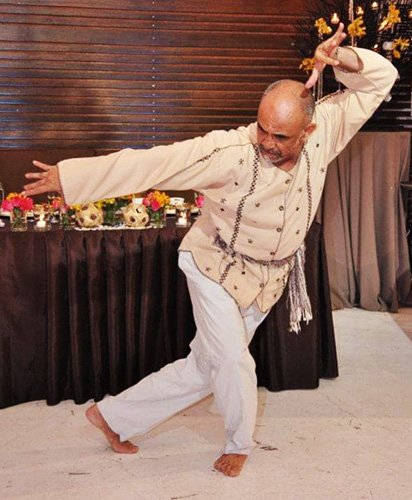
Edru Abraham in a candid dance pose. Wedding at Antipolo June 2015
I left the Chorus a year later, joining the Madrigal Singers in my senior year on a trip to Osaka to spend a month at Expo ’70, where we celebrated Philippine National Day on June 12. A shipload of musicians and dancers arrived just in time for the event, and I met Edru again. He had arrived in Osaka, together with his dance troupe, after a tour of Europe that ended just in time for them to join the festivities.
He was one of the primary dancers, performing as one of the fighting cocks in the dramatic “Sabong” section of the legendary “Filipinescas: Philippine Life, Legend and Lore in Dance” by Leonor Orosa Goquingco. The high jumps, vigorous kicks and iconic poses made it a signature piece, and Edru, with his restless energy, was unforgettable in the role. He doubled as the company percussionist, playing the many brass and bamboo instruments that accompanied the dancers. Goquingco, who had lived part of her life in Mindanao, had put her young dancers through workshops and sessions with musicians and dancers from the Northern Cordilleras, Mindoro, Palawan and Mindanao, to prepare them to perform their parts with more sensitivity to local culture. And Edru drank it all in. As he puts it, “Every opportunity I got within U.P. or anywhere else, I tried to learn as much as I could.”
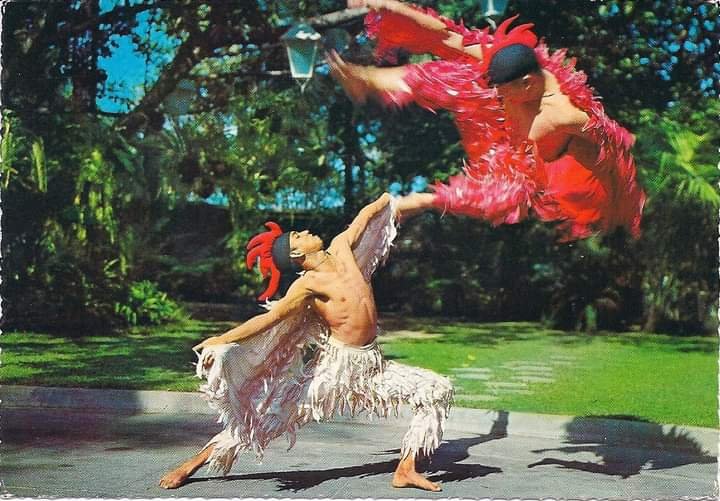
Filipinescas Dance Company "Sabong," a section of the full programme of PH life, legend & lore in dance choreographed by Natl Artist for Dance Leonor Orosa Goquingco. Edru Abraham plays the white cock while Rey Limcaco portrays the red cock.
After college, we lost track of each other for a long while, engrossed as we were in building careers and raising families. But as fatefully, in 1978, we both applied and were accepted to fill newly opened items in General Education at the Department of Humanities in U.P. Diliman - Edru to focus on dance and I, on music.
The Diliman Campus was in full intellectual ferment at the time. There was an earnest attempt to resituate us, not as colonial subjects of distant European or American lands, but as part of an older, deeper-rooted and wider-ranging Southeast Asian culture that stretched from Southern China to Madagascar. Edru and I, both mentored by our Department Chair, Felipe “Jun” de Leon, Jr., waded into the waters of Philippine and Asian Studies, trying to find stable positions from which to venture on our personal journeys of discovery.
Apocryphal tales handed down to us from our elders on the faculty emphasized the need to develop more and more curricular offerings in Philippine Arts out of the pitiful single course that they had struggled to put together in the 1960s. Looking back on those times, we realize, with some sense of pride, that by 2023, we had, as a collective, established 26 courses in Philippine Art with Edru developing two of these in Philippine dance and two more in Asian and Western dance.
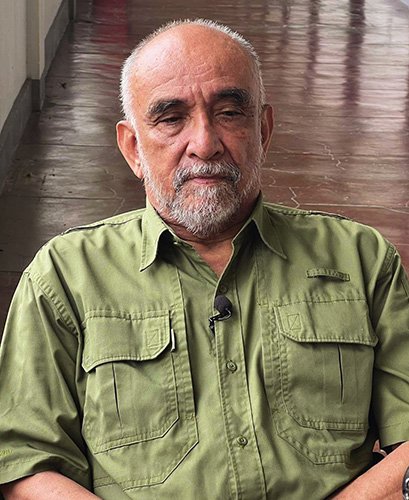
Edru at Palma Hall, UP Diliman during a video interview in connrction with the 1972 Declaration of Martial Law, 21 Sept 2022.
Edru’s practical forays in the realm of Philippine dance put him in a good position to organize and discuss his experiences as a dancer with young people getting their first taste of life outside the confines of the conservative and sectarian school system that had, only a decade before, imposed a “ballet ban” on young girls. Roman Catholic girls’ schools prohibited their students on pain of expulsion, from taking dance, or more specifically, ballet classes, because of the figure hugging, revealing dance garments the girls wore, and the suggestive and expressive body movements of the genre. This meant that folk dancing was the permissible alternative in the school system. Filipinescas existed between the two forms – classical ballet, which Goquingco taught her dancers, and state-organized folk dance, which she also used as raw material in her choreographies. Edru was trained to swing, not only back and forth between them, but also to throw the view from the musician’s point of reference into the mix.
During the ‘80s, after entering the Humanities Department (now the Department of Art Studies), Edru’s interest in sharpening his consciousness about being an artist in a very dynamic and swiftly changing socio-political climate resulted in his applying for two short-term scholarships - first, an eight-month-long DFA-ASEAN Scholarship in 1983 to Jogjakarta, Indonesia, where he studied performing and visual arts under the nationally revered Guru Bapak Bagong Kussudiardja of Central Java. This enriched his understanding of traditional Southeast Asian artistic process and practice, and creative organization and production technique. The second experience came courtesy of a human rights grant given by the U.K.-based “Writers and Scholars Educational Trust” that allowed him to travel all over Europe, observing conditions regarding press and artistic freedom and how these could be wielded to enrich and deepen perspectives over actual realities existing in the world.
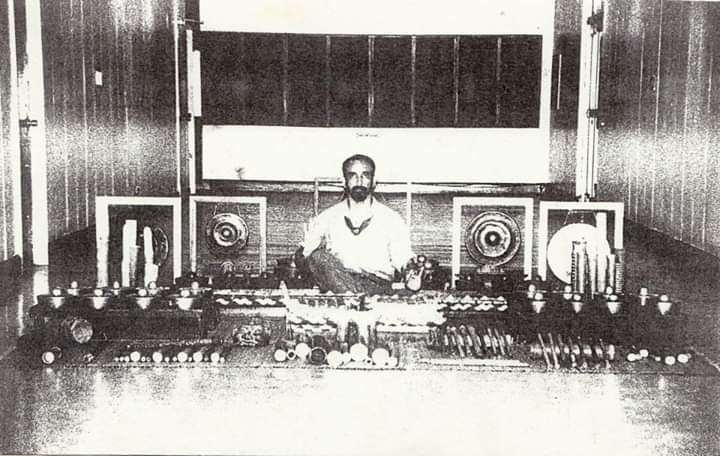
Edru seated with indigenous Philippine instrument 2nd floor Faculty Center, 1991
The result of these two life changing experiences is a lifelong commitment to artistic service to the nation and the building of a national consciousness through the arts. Edru’s projects have always brought these two planes of existence – the world of art and the life of the nation – together. An early project, ca. 1989, for example, was “Alay Ani: Tula at Awit sa Bayan at Bayani,” a collaboration between the poets Edgardo “Ed” Maranan and Domingo Landicho, whose vivid and powerful images set to words provided the fabric of social realism. Edru and Lester Demetillo, set the poems to music close to the heart. I had the privilege of occasionally joining the regular singers, that included Edru’s wife Becky Demetillo-Abraham, Susan Fernandez, and his daughter Astarte Abraham, onstage.
But the long-term testament to Edru’s dedication to his ultimate goal is the Kontemporaryong Gamelan Pilipino, more familiarly known as Kontra-GaPi, a performing arts ensemble unique in many ways:
1. Its assumption that every human being is an artist, capable of participating in the creation of expressive experiences that convey meaning,
2. Its contention that art must encourage individual creativity and expressive freedom in the pursuit of social and cultural justice,
3. Its use of Philippine traditional gongs and bamboo instruments in an unconventional contemporary ensemble resembling the gamelan of Southeast Asia,
4. Its experimentation in combining and developing sounds, rhythms and musical synchronies with dance and other theatrical elements, all connected in some way to traditional Austronesian music,
5. Its advocacy of the group and its collective creativity as an antidote to the deleterious effects of repressive and restrictive forces that constrict individual and group freedom in society, and
6. Its mission of raising awareness of the continuing existence of a Southeast Asian consciousness in Philippine art and its persistence in our culture despite colonial efforts to erase these memories.
Kontra-GaPi was founded in 1989, when Edru was commissioned to write a musical score for Dulaang U.P.’s production of Strindberg’s “A Dream Play,” with the instruction, “the music must be distinctly Filipino and Asian.” He assembled a group of enthusiastic, energetic young students, eager to explore the world of Philippine Music and remake it in their own image.
After the show’s run, the group found itself unwilling to disband and promptly converted itself into an independent performing organization within the university. Training the young to apply his improvisational methods and working with them to bring their talents to fore, together they created an iconic repertoire of bold, playful and provocative works. This program took them to many places all over the archipelago, attracting an audience searching for ways to express themselves as young Filipinos.

Open field photo of Kontra-GaPi, Pikkeling Harvest Festival, Belgium July 2013
KontraGaPi has performed all over the world as an ensemble, bringing this music to audiences surprised and delighted with the innovativeness of its repertoire. It has performed in highly regarded theatre productions such as Tanghalang Ateneo’s “Sintang Dalisay,” a Philippine adaptation of Shakespeare’s “Romeo and Juliet,” set in an imaginary Philippine Muslim community. “Sintang Dalisay” represented the Philippines in theatre festivals in Malaysia, Belarus, Vietnam and Taiwan, winning quite a number of awards along the way. KontraGapi has also attracted the attention of movie directors, including Marilou Diaz-Abaya (“Bagong Buwan”) and Lutgardo “Gardy” Labad (“Mulawin”), who sought the group to create specific cinematic atmospheres for their award-winning films.
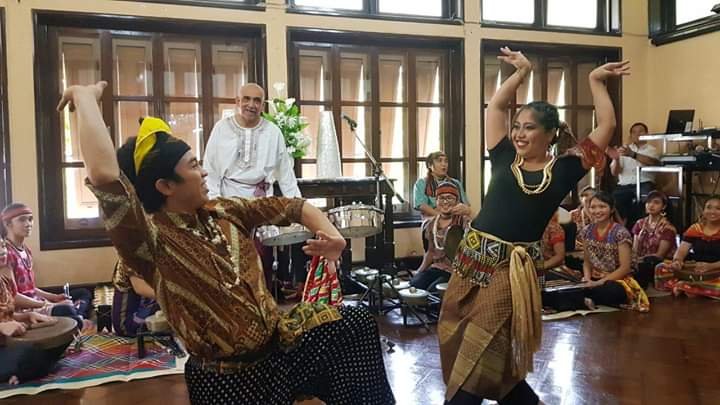
Live Kontra-GaPi performance at the Philippine Embassy. in Bangkok, Thailand, July 2019
But more important than the number of national and international engagements and awards KontrGaPi has racked up, is the hopefulness that Edru continues to bring with these performances, complete with accompanying lectures and workshops about the richness of the creative potential of the people, to almost every nook and cranny of the Philippines. KontraGaPi has survived the pandemic, taking in 15 new recruits from 2020 to the present and continuing to perform at least twice a week to enthusiastic audiences in various venues. They are now preparing for a three-week tour of Apayao, Cagayan and Kalinga in July and August of 2023.
Now in his retirement years, Edru continues to passionately continue the work he began in his youth through his mentorship of the young members of KontraGaPi, which is celebrating its 34th year. The group has not swerved from its commitment to raising awareness among the young that we do have a unique place in the world as citizens, not only of the Philippines, but also as part of the greater, more widespread culture of Southeast Asia and the Pacific. It exists as a valuable reminder that our past as an Austronesian people is dynamically interwoven with our present as a modern nation. Armed with this awareness, it enables us to chart directions and look forward to the future.

Elena Rivera Mirano is a Professor Emeritus of Art Studies at the University of the Philippines in Diliman. She served as Dean of the University of the Philippines (UP) College of Arts and Letters from 2009-15 and Director of the Cherubim and Seraphim, official children’s choir of UP Diliman from 1996 to the present.
To watch Edru Abraham and Kontra-GaPi:
OVERVIEW
A general introduction briefly demonstrating the style, scope & specific characteristics of Kontra-GaPi including its mission & purpose as a performing ensemble.
KAYA NG PINOY
(Live candid show)
A live performance with chant, gamelan instrumentation & dance showing in a total-theater style the uniqueness of the troupe. The lyrics of "Kaya ng Pinoy" was written by eminent poet Domingo Landicho and turned into a patriotic ethnic rap song.
This rendition took place at the UP Theater, Diliman.
GAME OF THRONES
Opening Theme Cover
With over two million hits on FB & over 400,000 views on YouTube this SEAsian interpretation of the theme music of the popular TV series of the same title could well serve as an intro to gamelan music to western music-oriented ears and a sampler of what this instrumental ensemble can do to transport the listener to a unique & exotic world.
ASEAN Youth Cultural Forum
Five Kontra-GaPi artists chant dance & play as many as twenty individual instruments in a performance of less than ten minutes. A dictum in the artistic life of Kontra-GaPi is that "Dance is Music seen even as Music is Dance heard."







No comments:
Post a Comment